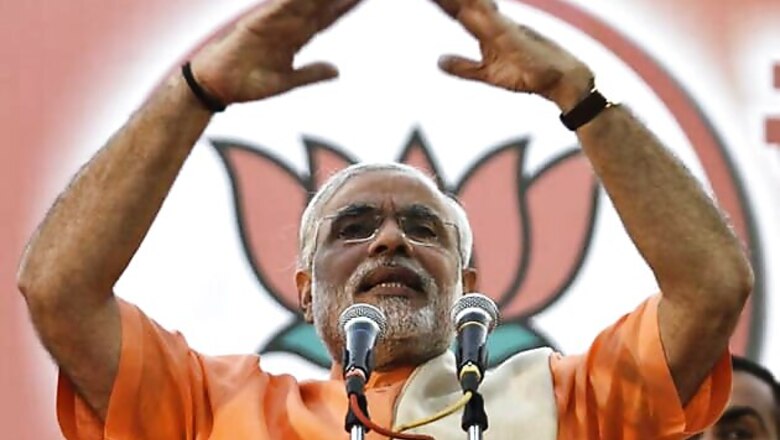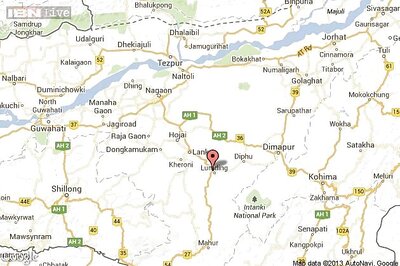
views
New Delhi: Perhaps the biggest battle in the 2014 Lok Sabha elections would be the battle for Varanasi. The temple town of Varanasi is believed to be the oldest living city in the world and as election frenzy reaches its zenith, the town is geared up to face one of the most interesting political contests ever. The BJP has finally taken a decision to field its prime ministerial candidate Narendra Modi from Varanasi. What has made the battle interesting is that Aam Aadmi Party's Arvind Kejriwal is all set to contest against Modi. The BSP and the Samajwadi Party have also announced their candidates and the Congress is also trying to field a credible face against Modi. What is it that makes Varanasi so special in Indian politics? Why has the BJP fielded its trump card Modi from Varanasi? Will Kejriwal's entry upset Modi's calculations? Will history back Modi?
Why Modi from Varanasi:
Modi will make an impact on approximately 86 seats. These include 32 seats of Poorvanchal, 40 seats of Bihar, and about 14 seats of Jharkhand, Chattisgarh, Madhya Pradesh. Modi will also have an impact on the rest of Uttar Pradesh. In this entire region, spanning across five states - BJP had managed only 40 seats out of around 150 seats. BJP's goal is to double its tally from this region. "Varanasi is a multi-lingual, multi-cultured hub where people from all regions, religions, caste and community live. Move to make Modi contest from this holy city is also seen as a move by the saffron party to send a signal to the voters that Modi has a pan India appeal," says a social scientist in BHU.
Voters breakup in Varanasi
Muslim: 3 lakh
Brahmin: 2 lakh
Bhumihar: 1 lakh
Yadav: 1 Lakh
Nishad and Rajbhar: 50000
Kushwah, Khatri, Chaurisia, Bengali, South Indians: 5 lakh
Other backward classes: 3 lakh
Mulayam goes to next to Varanasi - Azamgarh:
Mulayam clearly has three objectives in mind by deciding to contest from Azamgarh, besides his traditional seat Mainpuri. Firstly, vote polarization with Modi contesting from adjoining Varanasi. The Samajwadi Party wants to capture the polarization of Muslim votes in Poorvanchal that has resulted with Modi's entry into Varanasi.
Secondly, Poorvanchal is a traditional stronghold of Samajwadi Party. Eastern UP (or Poorvanchal) is traditionally a stronghold of Samajwadi Party. In the 2012 Assembly elections, out of 32 seats from this region SP managed a handsome tally of 15 seats seats. In 2009 Lok Sabha elections also SP won 8 seats from this region and came a close second in another 7 seats. By fielding himself from Azamgarh, Mulayam wants to send a clear message to voters how seriously the SP is taking this region.
Fissures within the Yadav family: Another important reason for Mulayam's decision to contest from Azamgarh (besides his traditional Mainpuri seat) is that he wants to make a foothold for his younger son Prateek Yadav who was himself interested to contest from Azamgarh but had to face opposition from his elder step brother and Chief Minister Akhilesh Yadav. Sources in SP say both brothers are not in good terms with each other and Mulayam wants to ensure that if he wins both the seats he would vacate Azamgarh for Prateek Yadav which would pave way for his political career.
The AAP factor:
Varanasi battle has become more interesting with the entry of AAP leader Arvind Kejriwal. AAP's goal is very simple. With the downfall of Congress, Kejriwal and AAP think tank believes by taking on Modi AAP is in a position to occupy the space of the principal opposition party. Kejriwal hopes to corner Modi on issues such as corrupt cabinet ministers in Modi's Gujarat government, gas price rise and farmer suicide issues.
Also by pitting himself against Modi in Varanasi, Kejriwal wants to send a positive message to its possible Muslim voters in other parts of the country.
To start with, Kejriwal will be holding a big road show in Varanasi on March 25 and in a typical AAP style, seek a 'referendum from the people of Benaras'. After getting people's blessings to contest, more than 150 key volunteers of AAP will reach Varanasi to strategize and start campaigning for Kejriwal in coordination with local AAP leaders. And once polling in Delhi is over on April 10, key AAP leaders will also move to Varanasi to start vigorous campaigning against Modi.
Congress:
At the moment Congress is facing a serious problem with several veteran party leaders preferring to opt out of the race. There is serious division within the Congress over fielding a candidate against BJP's prime ministerial candidate Modi. A section of the party wants the local leaders such as Ajay Rai to take on Modi, while others feel if they do not project a credible face against Modi, they will lose out in the battle of perception. So there are several senior names doing rounds in Congress, these include, former Madhya Pradesh CM Digvijaya Singh, Union Minister Anand Sharma. There are also unconfirmed reports that Congress might pitch in some filmstar against Modi.
The others:
Mukhtar Ansari who gave a strong fight to Murli Manohar Joshi in 2009 has a strong support base in Varanasi. The don-turned-politician got almost 1.8 lakh votes in the last elections. This time he is all set to contest on Kaumi Ekta Dal ticket from the holy city. The BSP on the other hand has fielded a businessman Vijay Prakash Jaiswal while SP has given ticket to Mirzapur MLA Kailash Chaurisia. Varanasi Lok Sabha has five Assembly segments - Rohaniya, Varanasi North, Varanasi South, Varanasi Cantonment, Sevapuri, with BJP holding three out of these five while SP and Apna Dal having one each. The Mayor seat is also with the BJP. So at the moment momentum is with the BJP.
Historically Varanasi reflects national mood:
Another interesting fact about Varanasi Lok Sabha seat is that historically, Varanasi has mostly thrown up results reflective of the national mood. It was Raghunath Singh of Congress who became the first MP from Varanasi (then known as Benaras) seat in 1952 and subsequently the Congress strongman won two more successive terms till his march was stopped in the general elections of 1967 by Satyanarayan Singh of the CPI and Benaras seat slipped from the hands of the Congress for the first time.
Congress lost two towering leaders in the death of Prime Minister Jawaharlal Nehru followed by Lal Bahadur Shastri in quick succession. Though Congress got a majority in the 1967 general elections its vote share declined dramatically and it lost power in as many as six states leading to dissent and power struggles within the party which was followed by a split in the party in 1969 with Indira Gandhi taking over the control of the party. In 1971 Congress under Indira Gandhi came back to power and a well known educationalist Raja Ram Shastri and vice chancellor of prestigious Kashi Vidhya Peeth won on a Congress ticket from Varanasi.
But Indira's popularity dwindled following imposition of Emergency and the first elections after lifting of Emergency in 1977 saw Congress losing power at the Centre. Varanasi truly reflected the national sentiment and Chandrashekhar (who later also became India's Prime Minister in 1990) got elected from Varanasi on a Janta Party ticket.
But Janta Party government collapsed in 1980 and Indira Gandhi came back to power at the Centre and Congress won back the Varanasi seat under well known journalist, writer Kamlapathi Tripathi who later also became the Chief Minister of UP. Following Indira Gandhi's assignation Congress swept the 1984 general elections and also retained Varanasi seat. But Mandal agitation saw Congress out of power in Delhi and in 1989 VP Singh became the prime minister, with Varanasi seat also slipping out of Congress' hands. Varanasi seat was won by former Prime Minister Lal Bahadur Shastri's son Anil Shastri who contested on a Janta Dal ticket. During the peak of Ram Mandir wave, Varanasi seat went to BJP though Congress under Narasimha Rao managed to form government at the Centre. BJP continued to hold Varanasi seat in 2004 but when Congress swept back to power in 2004 Dr Rajesh Kumar Mishra became the Congress MP from Varanasi. 2009 Lok Sabha elections were also an exception with BJP leader Murli Manohar Joshi winning the Varanasi seat but BJP unable to form a government in Delhi.
So historically, in most occasions Varanasi seat has always gone to the party or the coalition in power at the Centre - barring three occasions in 1991, in 1996 (when Congress supported Dewa Gowda government at Centre) and in 2009.
(The writer is CNN-IBN News Editor)
















Comments
0 comment